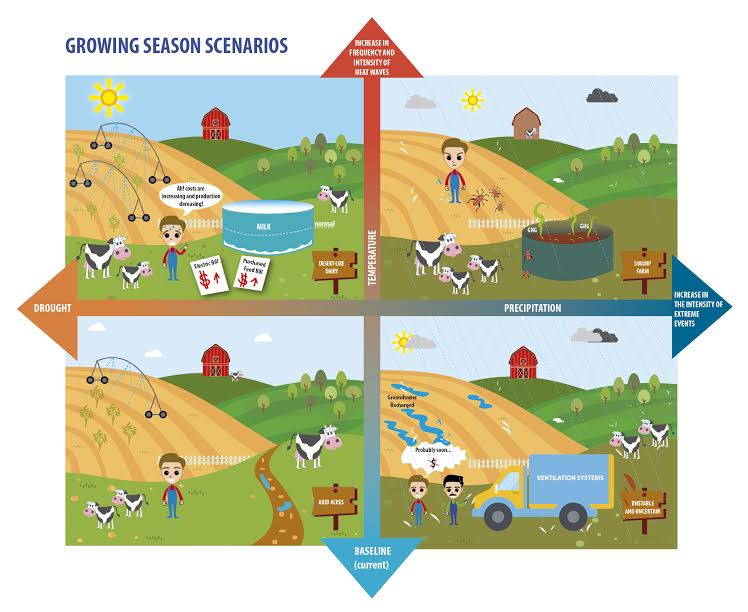Proceedings Home | W2W Home 
Purpose
Climate change is a slow and continual process that has been gradually changing our weather, and it will continue to occur. In order to adapt to such gradual changes, much foresight and planning is needed. The input-gathering process undertaken for this exercise was intended to compile information from stakeholders that was used to determine various scenarios of what future dairy production will look like, under specific climate change scenarios.
A survey of producers’ perspectives performed in 2014 yielded useful information regarding the beliefs of many New York State (NYS) dairy farmers. The survey showed that the majority of these farmers believe that they and their peers must adapt to climate changes they are currently facing, in the coming decades, in order to continue to grow and expand the industry in a sustainable manner. The scenario planning process will aid producers and their advisors in determining which adaptation strategies will be most effective to become more resilient to the climate changes that are projected in the near-term future for New York.
What did we do?
A Scenario Planning exercise was conducted throughout 2016 in preparation to help NYS producers imagine a future that involves the changes in climate that are projected over roughly the next 50 years. Scenario planning is a process that involves stakeholder input to develop multiple future scenarios based on a few key variables that will affect and change the way a system functions currently. It is a unique process in that it is not probability-based rather, it is based on the views of stakeholders and experts who choose the variables to be presented in a divergent fashion.
A workshop was held in July 2016 which gathered input from 12 stakeholders, and this input was then combined with current climate projections and other resources, to develop 8 comprehensive scenarios, 4 for the winter season and 4 for the growing season. The final scenarios are visual representations and are paired with qualitative narratives to explore the impacts of the divergent situations that are created. The final narratives provide a useful communications tool to share with farmers and other stakeholders, to explore the impacts of the climate variables involved.


What have we learned?
The exercise focused on temperature and precipitation changes for New York State, and the impacts to various aspects of the farmstead on a typical New York dairy farm. Scenarios were created for both winter and growing seasons, since the range of impacts is highly season dependent. The divergent scenarios created are presented in Figure 1 (growing season scenarios) and Figure 2 (winter season scenarios). Qualitative narratives were developed to describe in-depth the interactions that occur in each situation, for example, impacts to: the herd, the farmstead, manure management, farm economics, and finally with the farmer and personnel. Furthermore, once each situation is described fully, the next level of impact explores outside variables, for example, regional economic or political changes, population growth or social changes, or nation-wide or world-wide events that could have a significant impact on the specific farm situation presented.!
Future Plans
Next steps include identifying the best management strategies to handle the challenges presented in each resulting scenario. The final scenarios are presented in such a fashion that they will be useful tools to inform farm management, planning and decision making. The final scenarios can be used to examine how a certain set of management actions would perform under various future climatic conditions. “Robust” management actions need to be identified that would be the most highly effective under all scenarios considered, in other words, best management practices need to be identified that make the most sense to invest in, to be prepared for as many of the scenarios created as possible. In the same effort, it is important to identify management actions that are ineffective or that have little impact for a majority of the future scenarios developed. Pursuing actions that only work under a few of the projected scenarios is not in! line wit h smart planning to make the farm as resilient as possible. This preparation is a significant step towards helping farms be resilient in the face of unexpected future changes.
Corresponding author, title, and affiliation
Jennifer Pronto, Co-founder, BioProcess Analytics, LLC
Corresponding author email
Other authors
Curt Gooch, PE, Cornell University
The authors are solely responsible for the content of these proceedings. The technical information does not necessarily reflect the official position of the sponsoring agencies or institutions represented by planning committee members, and inclusion and distribution herein does not constitute an endorsement of views expressed by the same. Printed materials included herein are not refereed publications. Citations should appear as follows. EXAMPLE: Authors. 2017. Title of presentation. Waste to Worth: Spreading Science and Solutions. Cary, NC. April 18-21, 2017. URL of this page. Accessed on: today’s date.

